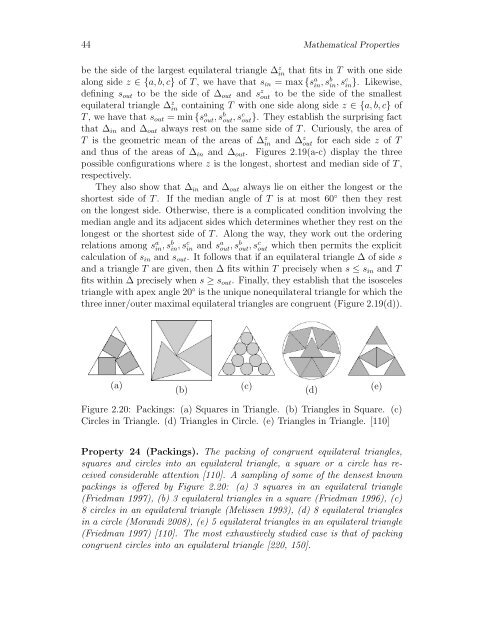MYSTERIES OF THE EQUILATERAL TRIANGLE - HIKARI Ltd
MYSTERIES OF THE EQUILATERAL TRIANGLE - HIKARI Ltd
MYSTERIES OF THE EQUILATERAL TRIANGLE - HIKARI Ltd
You also want an ePaper? Increase the reach of your titles
YUMPU automatically turns print PDFs into web optimized ePapers that Google loves.
44 Mathematical Properties<br />
be the side of the largest equilateral triangle ∆ z in that fits in T with one side<br />
along side z ∈ {a, b, c} of T, we have that sin = max{s a in, s b in, s c in}. Likewise,<br />
defining sout to be the side of ∆out and s z out to be the side of the smallest<br />
equilateral triangle ∆ z in containing T with one side along side z ∈ {a, b, c} of<br />
T, we have that sout = min{s a out, s b out, s c out}. They establish the surprising fact<br />
that ∆in and ∆out always rest on the same side of T. Curiously, the area of<br />
T is the geometric mean of the areas of ∆ z in and ∆ z out for each side z of T<br />
and thus of the areas of ∆in and ∆out. Figures 2.19(a-c) display the three<br />
possible configurations where z is the longest, shortest and median side of T,<br />
respectively.<br />
They also show that ∆in and ∆out always lie on either the longest or the<br />
shortest side of T. If the median angle of T is at most 60 ◦ then they rest<br />
on the longest side. Otherwise, there is a complicated condition involving the<br />
median angle and its adjacent sides which determines whether they rest on the<br />
longest or the shortest side of T. Along the way, they work out the ordering<br />
relations among s a in, s b in, s c in and s a out, s b out, s c out which then permits the explicit<br />
calculation of sin and sout. It follows that if an equilateral triangle ∆ of side s<br />
and a triangle T are given, then ∆ fits within T precisely when s ≤ sin and T<br />
fits within ∆ precisely when s ≥ sout. Finally, they establish that the isosceles<br />
triangle with apex angle 20 ◦ is the unique nonequilateral triangle for which the<br />
three inner/outer maximal equilateral triangles are congruent (Figure 2.19(d)).<br />
(a)<br />
(b) (c) (d) (e)<br />
Figure 2.20: Packings: (a) Squares in Triangle. (b) Triangles in Square. (c)<br />
Circles in Triangle. (d) Triangles in Circle. (e) Triangles in Triangle. [110]<br />
Property 24 (Packings). The packing of congruent equilateral triangles,<br />
squares and circles into an equilateral triangle, a square or a circle has received<br />
considerable attention [110]. A sampling of some of the densest known<br />
packings is offered by Figure 2.20: (a) 3 squares in an equilateral triangle<br />
(Friedman 1997), (b) 3 equilateral triangles in a square (Friedman 1996), (c)<br />
8 circles in an equilateral triangle (Melissen 1993), (d) 8 equilateral triangles<br />
in a circle (Morandi 2008), (e) 5 equilateral triangles in an equilateral triangle<br />
(Friedman 1997) [110]. The most exhaustively studied case is that of packing<br />
congruent circles into an equilateral triangle [220, 150].

















